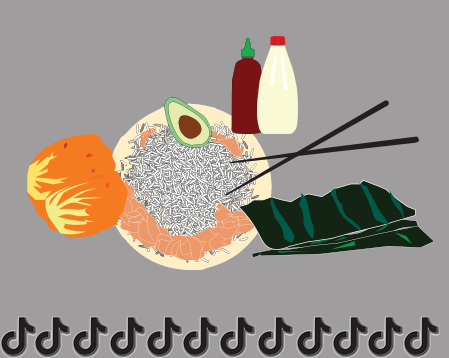TikTok Influencer Emily Mariko Finds Comfort in the Mundane
How simple content captivates audiences and sets unrealistic expectations

Emily Mariko’s life is TikTok-perfect in a very soothing way.
November 10, 2021
Emily Mariko, queen of clean counters and beautiful meals, is one of the most recent viral content creators on TikTok.
Content creators like Mariko try their hardest to create engaging content on TikTok within its three-minute time restriction. Some TikToks emulate mini stand-up shows, dance performances or cinematic experiences, while another side of TikTok explores the entirely mundane.
Unlike the creators who make exciting, fast-paced content, Mariko’s brand relies on the seemingly simple. Her first viral video documented nothing more than her making lunch. There was no audio, aside from the clanking of dishes or the microwave running — no voiceover, no instructions, no music.
I can easily sit in my bed and watch her make her lunch three times in a row.
The video starts with her opening the fridge and pulling out the ingredients, and it ends with her taking the first bite of her lunch. The editing is extremely choppy, showing the entire process of the lunch assembly, but each step is only shown for one to two seconds. This video launched Mariko into TikTok stardom — her page now has 7 million followers, and her most popular meal prep video accumulated over 28 million views.
Personally, I love watching Mariko’s TikToks. I can easily sit in my bed and watch her make her lunch three times in a row. Although I have a world of entertainment at my fingertips that could make me laugh or cause me to marvel at CGI and special effects, I feel a strange pull to mundane content. After contemplating the allure for some time, I believe there could be a few reasons as to why Mariko has found such success.
Interestingly enough, the internet trends are reminiscent of the fashion industry. Ten years ago, skinny jeans were all the rage, as were YouTube challenges, such as the cinnamon challenge or the chubby bunny challenge.
As I watch Mariko’s TikTok and hear the clanking of her clean white plate being placed on her spot-free granite countertops, or see the seaweed being wrapped around salmon, rice and avocado, the sounds are satisfying. There is an extremely calming element to such simple, recognizable sounds.
Aside from the calming feelings that come from watching Mariko’s TikToks, I also experience a strange mix of emotions. Inspiration, insecurity and envy simultaneously run through me when I click on her page.
On one hand, Mariko could easily represent a symbol of hope for students on a budget like myself. Young college students, who are often short on money, are living in a transient state and rarely have an aesthetically pleasing life. Most of us are living in dorms or cheap apartments, are eating inexpensive, easy-to-make meals, and are in a stressful, chaotic time of life.
Mariko offers a glimpse into what life could be like if we had more money: a nicer apartment and enough time to make ourselves a beautiful lunch. For the three minutes that I am watching her video, I am transported into a life I wish was my own.
Among many contributing factors, the false presentation of someone’s life could be a driving force behind feelings of envy and inferiority.
However, I cannot ignore the sting of anger and jealousy that I experience while watching her TikToks. There are links between social media and damages to the mental health of the person consuming the content. Among many contributing factors, the false presentation of someone’s life could be a driving force behind feelings of envy and inferiority.
With the rise of social media, people have been pressured to post their best selves online: videos of fun at parties, photoshopped images and perfect moments in relationships. This imbalanced perception of someone’s life can be extremely frustrating.
Mariko only paints a perfect picture of her apartment, diet and relationship, so I am drawn back to her page when my life feels imperfect. It’s a complicated dynamic, but there is a sense of curiosity along with envy that drives my viewership of Mariko and any other creator whose life seems perfect.
Mariko remains popular on TikTok, posting daily, and she also has a successful YouTube account. It is almost certain that her internet presence will remain strong for the near future, and I can confidently say that I will continue to watch her make lunch. Furthermore, I think she will continue to provide a comforting escape for college students when they want to imagine a more put-together life for themselves.












